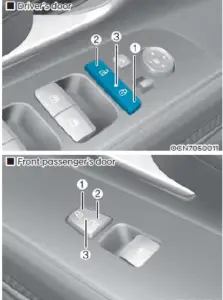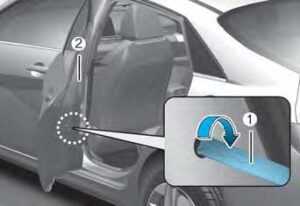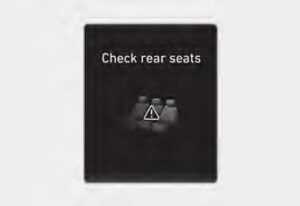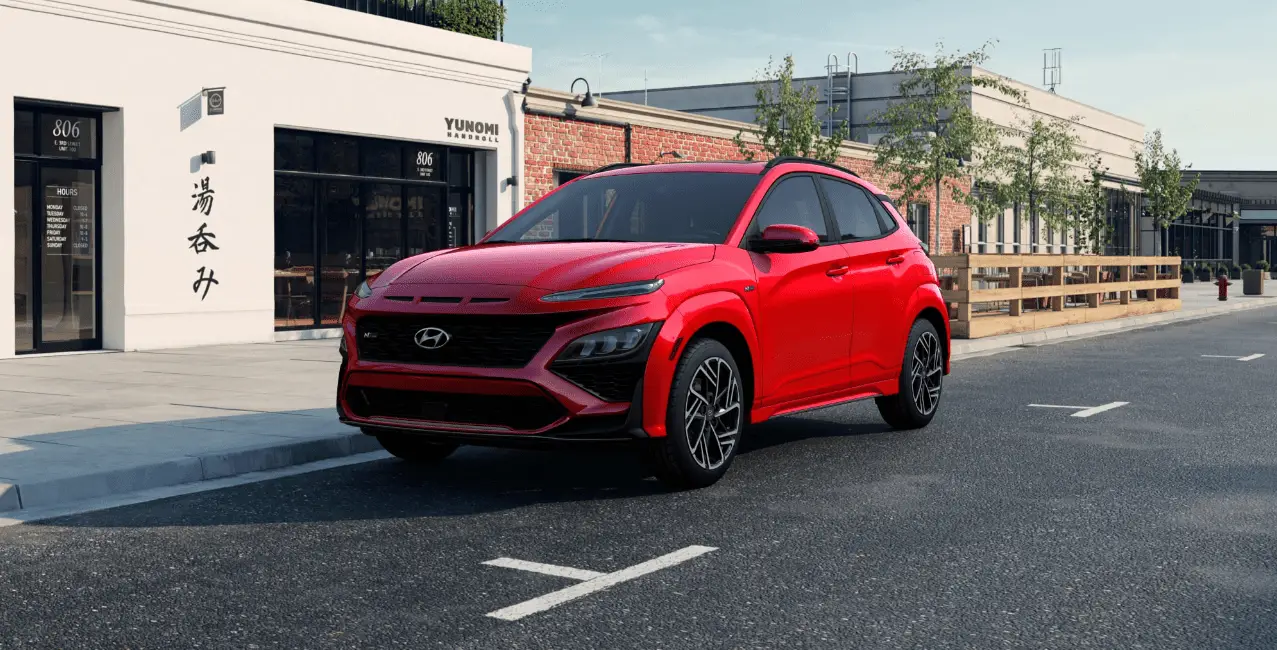2023 Hyundai Kona Door Locks and Rear Occupant
In terms of convenience and safety, the 2023 Hyundai Kona Door Locks and Rear Occupant Guidelines cover a crucial area. These guidelines emphasize the significance of keeping doors secured while driving and include detailed advice on how to operate and secure the locks to prevent illegal access. The usage of child safety locks and the possible dangers of leaving rear passengers unattended are other ways they handle the safety of rear occupants, especially kids and pets. These principles, which prioritize security and the safety of passengers, perfectly capture Hyundai’s commitment to providing a responsible and safe driving experience for drivers of the 2023 Kona.
2023 Hyundai KONA Specs, Price, Features, Milage (Brochure)
Door Locks
Operating Door Locks from Outside the Vehicle
Mechanical key

- Press the lever located under the cover with mechanical key. (1)
- While pushing the lever so that the mechanical key does not fall out of the cover hole, slowly push it towards the rear of the vehicle and remove the cover. (2)
- After removing the cover, only driver’s door can be locked or unlocked by using mechanical key.
- Turn the key toward the rear of the vehicle to lock and toward the front of the vehicle to unlock. (3)
If you lock/unlock the driver’s door with a key, the driver’s door will lock/ unlock automatically. Once the door is unlocked, it may be opened by pulling the door handle. Make sure that doors are closed securely.
Information
Be careful when locking the door by mechanical key operation, only the driver’s door can be locked/unlocked. Refer to Chapter 5 “Operating door locks from inside the vehicle” to lock from inside the vehicle.
Information
When removing the cover, be careful not to lose cover and any scratches. When the key cover freezes and does not open, lightly tap or indirectly warm(hand temperature, etc.) it. Do not apply excessive force to the door and door handle. It may be damaged.
Remote key

To lock the doors, press the Door Lock button (1) on the remote key. To unlock the doors, press the Door Unlock button (2) on the remote key. Once the doors are unlocked, they may be opened by pulling the door handle. When closing the door, push the door by hand. Make sure that doors are closed securely.
Smart key

To lock the doors, press the button on the outside door handle while carrying the smart key with you or press the door lock button on the smart key. To unlock the doors, press the button on the outside door handle while carrying the smart key with you or press the door unlock button on the smart key. Once the doors are unlocked, they may be opened by pulling the door handle. When closing the door, push the door by hand. Make sure that doors are closed securely.
Information
In cold and wet climates, door lock and door mechanisms may not work properly due to freezing conditions. If the door is locked/unlocked multiple times in rapid succession with either the vehicle key or door lock switch, the system may stop operating temporarily in order to protect the circuit and prevent damage to system components. Two press unlock setting can be changed in the User Settings mode on the cluster.
Operating Door Locks from Inside the Vehicle
With the door handle

Front door
If the inner door handle is pulled when the door is locked, the door will unlock and open.
Rear door
If the inner door handle is pulled once when the door is locked, the door will unlock. If the inner door handle is pulled once more, the door will open. If any door is opened, the doors will not lock even though the central door lock switch is pressed.
Information
If a power door lock ever fails to function while you are in the vehicle try one or more of the following techniques to exit:
- Operate the door unlock feature repeatedly (both electronic and manual) while simultaneously pulling on the door handle.
- Operate the other door locks and handles, front and rear.
- Lower a front window and use the mechanical key to unlock the door from outside.
With the central door lock switch

- When pressing the ( ) portion (1) of the switch, all vehicle doors will lock.
- If any door is opened, the doors will not lock even though the central door lock switch (1) is pressed.
- When pressing the ( ) portion (2) of the switch, all vehicle doors will unlock.
- Doors indicating light (3)
When all vehicle doors are locked, the indicating lights on the driver’s door and passenger’s door will turn on. If any door is unlocked, it would go off.
WARNING
The doors should always be fully closed and locked while the vehicle is in motion. If the doors are unlocked, the risk of being thrown from the vehicle in a crash is increased. Do not pull the inner door handle of the driver’s or passenger’s door while the vehicle is moving.
WARNING
Do not leave the elderly, children or animals unattended in your vehicle. An enclosed vehicle can become extremely hot, causing death or serious injury to the elderly, unattended children or animals who cannot escape from the vehicle. Children might operate features of the vehicle that could injure them, or they could encounter other harm, possibly from someone gaining entry to the vehicle.
WARNING
Always secure your vehicle. Leaving your vehicle unlocked increases the potential risk to you or others from someone hiding in your vehicle. To secure your vehicle, while depressing the brake, move the shift lever to the P (Park) position, engage the parking brake, and place the ignition switch in the LOCK/OFF position, close all windows, lock all doors, and always take the key with you.
WARNING
If you stay in the vehicle for a long time while the weather is very hot or cold, there are risks of injuries or danger to life. Do not lock the vehicle from the outside when someone is in the vehicle.
WARNING
Opening a door when something is approaching may cause damage or injury. Be careful when opening doors and watch for vehicles, motorcycles, bicycles or pedestrians approaching the vehicle in the path of the door.
Automatic Door Lock and Unlock Features
Impact sensing door unlock system (if equipped)
All doors will be automatically unlocked when an impact causes the air bags to deploy.
Speed sensing door lock system (if equipped)
All doors will be automatically locked when vehicle speed exceeds 9 mph (15 km/h). You can activate or deactivate the Auto Door Lock/Unlock features from the User Settings Mode on the LCD display. For more details, refer to “LCD Display” in chapter 4. If your vehicle is equipped with additional navigation, please refer to the infotainment system manual separately supplied.
Child-Protector Rear Door Locks
 The child safety lock is provided to help prevent children seated in the rear from accidentally opening the rear doors. The rear door safety locks should be used whenever children are in the vehicle. The child safety lock is located on the edge of each rear door. When the child safety lock is in the lock position, the rear door will not open if the inner door handle is pulled. To lock the child safety lock, insert a key (or screwdriver) (1) into the hole and turn it to the lock position. To allow a rear door to be opened from inside the vehicle, unlock the child safety lock.
The child safety lock is provided to help prevent children seated in the rear from accidentally opening the rear doors. The rear door safety locks should be used whenever children are in the vehicle. The child safety lock is located on the edge of each rear door. When the child safety lock is in the lock position, the rear door will not open if the inner door handle is pulled. To lock the child safety lock, insert a key (or screwdriver) (1) into the hole and turn it to the lock position. To allow a rear door to be opened from inside the vehicle, unlock the child safety lock.
WARNING
If children accidently open the rear doors while the vehicle is in motion, they could fall out of the vehicle. The rear door safety locks should always be used whenever children are in the vehicle.
Rear Occupant Alert (ROA)
Rear Occupant Alert helps prevent the driver from leaving a passenger in the rear seats.
Rear Occupant Alert Operation

When the driver turns off the engine and opens the driver’s door after opening and closing a rear door, a warning message “Check rear seats” appears.
WARNING
Rear Occupant Alert provides information to the driver to check the rear seats but it does not detect whether there is an object or passenger. Always check the rear seats when leaving the vehicle.
Information
The open and close history of the rear door is initialized if the driver turns off the engine and lock vehicle doors. However, the alarm may sound again whenever the driver’s door is opened if the previous history of the rear door is not initialized.
FAQ
The 2023 Hyundai Kona comes equipped with power door locks that can be operated using buttons on the key fob, the interior door panels, or the central control console.
Yes, the driver can usually control all the door locks in the Hyundai Kona from the central control console or the driver’s side door panel.
Yes, many trim levels of the 2023 Hyundai Kona come with a keyless entry system that allows you to lock and unlock the doors without using the physical key.
The Rear Occupant Alert (ROA) is a safety feature that reminds the driver to check the rear seats before leaving the vehicle. It aims to prevent leaving children or pets unattended in the back seat.
The ROA system uses sensors to detect if the rear doors were opened before the vehicle was started. After the driver turns off the engine and exits the vehicle, the system will activate. If the rear doors are not opened again after the vehicle is parked, the system will trigger an alert, which can include honking the horn and sending notifications to the driver’s smartphone.
Yes, many vehicles with the ROA feature allow you to enable or disable it through the settings menu in the infotainment system.
If the ROA system is triggered and detects movement in the rear seats after the driver has left the vehicle, it will issue alerts to capture the driver’s attention and prompt them to check the back seat.
No, the ROA system typically activates when the engine is turned off and the driver exits the vehicle.
The availability of the ROA feature might vary depending on the trim level and optional packages of the 2023 Hyundai Kona. It’s recommended to check the specifications for the specific model you’re interested in.
Yes, many vehicles with the ROA feature offer smartphone connectivity, allowing you to receive notifications on your phone if the system is triggered.
The ROA system is primarily designed to remind drivers to check the rear seats, where children and pets are more likely to be left unattended. It may not have the same level of focus on the front seats.
The sensitivity settings of the ROA system may not be customizable in all vehicles. It’s best to refer to the owner’s manual or the vehicle’s settings to see if adjustments are possible.
The accuracy of the ROA system’s movement detection can vary based on sensor technology and environmental conditions. Manufacturers strive to make these systems as accurate as possible to ensure safety.
The ROA feature generally doesn’t require regular maintenance or calibration. However, it’s important to keep the sensors and related components clean and free from obstructions for optimal performance.
While the ROA system is designed to monitor for occupants in the back seat, it might not be the best fit if you often transport items that could trigger false alerts. In such cases, you can consider disabling the feature when necessary.
Useful Link
Hyundai Kona 2023 All Wheel Drive (AWD) User Guide
Hyundai Kona 2023 Cruise Control (CC) User Guide
2023 Hyundai KONA Specs, Price, Features, Milage (Brochure)


